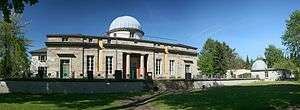Göttingen Observatory
 | |
| Location | Göttingen, Germany |
|---|---|
| Coordinates | 51°31′42.54″N 9°56′35.8″E / 51.5284833°N 9.943278°ECoordinates: 51°31′42.54″N 9°56′35.8″E / 51.5284833°N 9.943278°E |
| Established | 1816 |
| Website | http://www.astro.physik.uni-goettingen.de/index.de.html |
|
| |
Göttingen Observatory (Universitätssternwarte Göttingen (Göttingen University Observatory) or königliche Sternwarte Göttingen (Royal Observatory Göttingen)) is a German astronomical observatory located in Göttingen, Lower Saxony, Germany.
History
In 1802, George III of the United Kingdom, who was also the prince-elector of Hanover, allocated 22,680 thalers for a new observatory. The plans were developed, like many of the university's buildings, by Georg Heinrich Borheck.[1] Construction was delayed by the French Revolutionary Wars and extended from 1803 until 1816. At the time, the building was on the outskirts of Göttingen, to ensure an unobstructed view of the night sky.
Carl Friedrich Gauss became the first director of the Observatory, and lived there between 1815 and 1855.[1] Gauss arranged for the installation of two meridian circles (produced by Johann Georg Repsold and Georg Friedrich von Reichenbach in 1818 and 1919. [1]
Gauss was succeeded by Wilhelm Weber and Peter Gustav Lejeune Dirichlet, who served as provisional directors (though neither was an astronomer), and Dirichlet was replaced, upon his death, by Gauss's former assistant, Ernst Friedrich Wilhelm Klinkerfues. In 1868, the research institution was divided into theoretical and practical sections, with the former moving to Hainberg hill. Some problems of the building were fixed by renovations between 1887 and 1888. Klinkerfues continued to run the observatory until his death in 1884, and Karl Schwarzschild assumed the directorship in 1901. Scharzschild was succeed as director first by Johannes Franz Hartmann, and then by Hans Kienle.
Outposts
To improve observations, a new observatory was planned on the Hainberg, a small hill south east of Göttingen. After the opening of a new observatory there in 1929, the instruments were transferred from Göttingen to this new location. Due to the construction of a new telescope at Hainberg, observations at Göttingen Observatory were halted in 1933.
In 1941, during World War II, Paul ten Bruggencate became the director of the Göttingen University Observatory. In pursuit of his interest in observing the Sun, he looked for a new solar telescope. With the help of the military, he was able to build a solar telescope near the already existing telescope at Hainberg.[2][3] Unsatisfied with the cloudy weather conditions in Germany, ten Bruggencate established another solar observatory in Switzerland: the Locarno Observatory was planned and built in the late 1950s.[4] It was closed in 1984 and the equipment was transferred to the Teide Observatory in Tenerife, Spain,[5] where the University of Göttingen now shares the operation of several solar telescopes.
Further use
The institute was later directed by Hans-Heinrich Voigt, Rudolf Kippenhahn, Klaus Fricke, Klaus Beuermann and finally, by Stefan Dreizler.
After renovations, most recently in 2008, the observatory building was restored to its original appearance.[6] [1]
Since 2009, the Observatory has housed the Lichtenberg-Kolleg Institute for Advanced Study.[7]
See also
References
- 1 2 3 4 "Historic Observatory". Lichtenberg-Kolleg. 25 June 2013. Retrieved 12 June 2016.
- ↑ Jäger, F. W. (1962). "Nachruf auf P. ten Bruggencate". Mitteilungen der Astronomischen Gesellschaft. 15: 21–23. Bibcode:1962MitAG..15...21J.
- ↑ Kienle, H. (1962). "Paul ten Bruggencate 24.2.1901 14.9.1961". Die Naturwissenschaften. 49 (4): 73. Bibcode:1962NW.....49...73K. doi:10.1007/BF00622019.
- ↑ "Istituto Ricerche Solari Locarno". Retrieved 2010-04-25.
- ↑ "Das Gregory Coude Teleskop auf Teneriffa". University Göttingen. Retrieved 2010-04-25.
- ↑ Borheck, Georg Heinrich; Beuermann, Klaus (2005). Grundsätze über die Anlage neuer Sternwarten unter Beziehung auf die Sternwarte der Universität Göttingen. Universitätsverlag Göttingen. ISBN 978-3-938616-02-4.
- ↑ http://www.uni-goettingen.de/en/observatory/91323.html